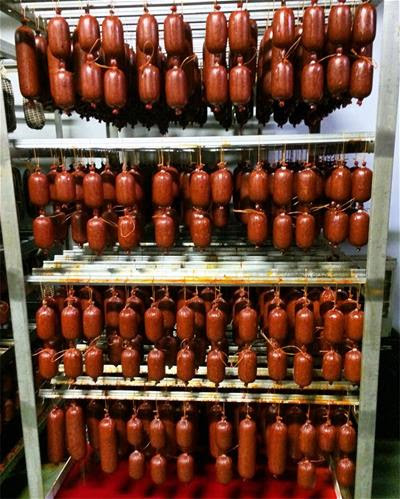If you’ve gone out to eat or looked at menus for restaurants in New York City in the last few years, there’s a good chance you’ve noticed one ingredient show up again and again: nduja. It’s everywhere: in egg dishes, on burgers, with pasta, with vegetables, with fish or shellfish, with cheese. Its status as the darling ingredient of hip chefs is remarkable to me because a few decades ago it was all but unknown in the US.
What the heck is nduja, anyway?
Nduja (pronounced en-doo-ya) is soft, spreadable cured pork, spiked with plenty of chiles. In the charcuterie world, nduja falls into the category of “spreadable salamis” (I promise that’s a real thing). Mmm, spreadable meat—can’t you just picture Homer Simpson mumbling it? You might think of it as spicy pork butter, though there’s no dairy involved.
It starts out like salami: raw pork and pork fat are mixed together with seasonings, then hung to cure for several weeks. Like all salamis, nduja was traditionally made with the meat left from butchery. The difference that makes salami solid and nduja spreadable is in the proportions. Most salami is about 75-80% lean meat and 20-25% fat. Nduja is the opposite. All that extra fat makes the texture luscious and spreadable.
A few decades ago, nduja was all but unknown outside its hometown of Spilinga in Calabria, the region in the toe of Italy’s boot. Calabria has long been known for its fruit and spicy chiles. Nduja is a more recent export. In fact, the nduja we get today isn’t an export at all—in the US it’s illegal to import Italian salami, so essentially all of the “Italian-style” salamis you see at the store are made right here in the states. Maybe nduja stayed a secret because of those tricky export laws or maybe the people of Spilinga just wanted to keep it all for themselves. But eventually word got out, and over the last decade it’s been making a big impression in the food world. It’s no surprise—tasting nduja for the first time is a memorable event. There’s the punch of spice, the unctuous richness, the silky texture, the deep, savory meatiness. The Wall Street Journal’s Jane Black said: “If Joan Jett were an Italian, and a sausage, she’d be ‘nduja.”
Our nduja is made by Tony Fiasche, a fifth-generation nduja maker.
Tony’s grandparents owned a butcher shop near Spilinga. Tony’s father, Agostino, was born there and grew up helping his father in the shop. As a boy he remembers breaking down whole hogs and grinding meat by hand with a crank—”not like we do today!” he recalls. Growing up, he says “my parents didn’t have money to buy me shoes. But there was always bread, always salami, always nduja.” He ate it on bread, mixed into pasta, on pizza.
Agostino raised his family in Chicago, where for more than thirty years he’s made a living running a restaurant. Tony started working at the restaurant at age 12, and later moved onto other restaurants in Chicago, including the famed pork palace, Publican. While there, he started making charcuterie. A few years ago, Tony broke out on his own and launched his company Nduja Artisans with his father.
Tony’s nduja starts with heritage-breed pork and chiles imported from Calabria.
His classic recipe features Berkshire pork. Berkshire is one of the most popular heritage breeds with chefs. It’s tender and has big flavor—to me it’s especially “porky.” Tony gets his Berkshire pork from a collection of family farms in southwest Minnesota. The pigs live free range, roaming and rooting as they please, spending their days outdoors as the weather permits. They never receive subtherapeutic antibiotics or growth-promoting hormones.
Berkshire isn’t the only pig in town, though. Once in a while, Tony gets his hands on Ibérico de bellota pork from the famous black-footed Ibérico pigs of southern Spain. The heritage breed of heritage breeds, these hogs rest in oak forests, eating as many acorns (bellotas in Spanish) as they can. The acorn diet has a magical effect on the pig’s fat. When the meat is cured, that fat practically melts on your tongue. Made into nduja with its high fat content, the effect is amplified. The texture is even silkier than usual, the flavor deeper and more intense, with a heat that slowly builds and builds. It’s heady stuff.
Of course, with the recent nduja craze, Tony’s not the only one making it. One less traditional approach comes from the pork curing masterminds at La Quercia in Iowa. Rather than make their nduja with raw pork, they begin with the trimmings leftover from their prosciutto, speck, and coppa, after the meat has cured for months. While there’s still plenty of spice involved, the smooth, savory flavor of the cured pork carries through.
Eight ways to use nduja this weekend:
1. Spread some on an egg sandwich
2. Stir it into tomato sauce for pasta or to top a pizza
3. Smear some in a grilled cheese or on a burger
4. Add a spoonful or two to an omelet
5. Melt some in a pan to add to broccoli or Brussels sprouts
6. Rub it under the skin of a chicken before roasting
7. Whisk a dollop into a rich, spicy vinaigrette
8. Simmer it in a broth with mussels or clams

